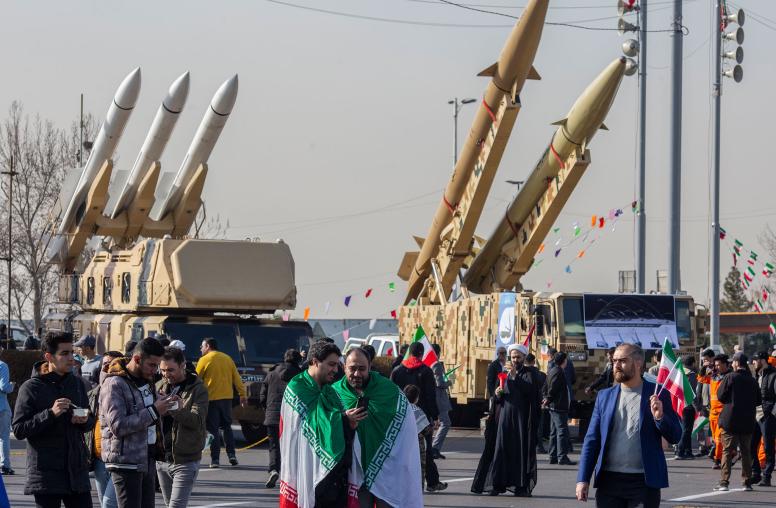What You Need to Know About Japan’s New National Security Strategy
Amid rising threats from China and North Korea, Tokyo’s debuts counterstrike capabilities and boosts defense spending.
Japan released on Friday a new, robust national security strategy and complementary defense planning documents. The strategy is Japan’s first in nearly 10 years and only its second ever. The strategy navigates the country’s response to significant changes in the regional and global security environment, including Russia’s invasion of Ukraine, and reflect Japan’s growing sense of vulnerability vis-à-vis its immediate neighbors. USIP’s Mirna Galic looks at the new strategy and what it means for the region.

What is the headline?
The most remarked upon aspect of Japan’s security documents will certainly be the authorization of what Japan calls counterstrike capability, which refers to the capacity to hit missile-related sites within an attacking country. Japan’s long-standing aversion to such a capability has been facilitated by a combination of missile defenses (to shoot down missiles already in flight) and reliance on U.S. strike capability. However, North Korea’s precipitously increasing rate of missile launches, as well as the modernization and diversification of China’s missile arsenal, has made it easier to justify the need to increase Japan’s own deterrence and defense. This is evidenced by public opinion, with over 60 percent supporting counterstrike capability, something that seemed unimaginable even a decade ago.
Successive governments have interpreted Japan’s constitution to allow the use of force to defend Japan’s territory only in response to an actual attack (not if there is just a likelihood or threat of attack) and to disallow “armaments deemed to be offensive weapons designed to be used only for the mass destruction of another country” (such as intercontinental ballistic missiles, long-range strategic bombers or “attack aircraft carriers”). Counterstrike capability has been controversial in Japan because the weapons it requires can also be used offensively and because it can be difficult to pinpoint when an enemy attack using a missile has technically begun before the missile is actually airborne.
To address these concerns, Prime Minister Fumio Kishida’s administration has called for a system to ensure counterstrikes are responsive and not preemptive. The National Security Strategy (NSS) also describes counterstrike capability as an additional component of Japan’s broader missile countering measures, not a replacement, noting “we need counterstrike capabilities: capabilities which, in the case of missile attacks by an opponent, enable Japan to mount effective counterstrikes against the opponent to prevent further attacks while defending against incoming missiles by means of the missile defense network.” Additionally, the document explicitly rejects pre-emptive strike: “Needless to say, preemptive strikes, namely striking first at a stage when no armed attack has occurred, remain impermissible.”
It is important to understand that, regardless of the counterstrike capability question, Japan’s exclusively defense-oriented policy already allows the country to use force in self-defense as soon as an attack has been initiated, the precise determination of which is based on various case-specific considerations. However, such force can only be used in the absence of other “appropriate means” and to the “minimum necessary extent.” The new counterstrike capability authorization does not change this — what it does do is expand the mechanisms Japan can use to service its defense policy, in this case, weapons that can counter a strike on Japan within enemy territory.
To actually serve as a deterrent, the authorization for counterstrike capability has to be institutionalized — this means greater capacity for intelligence, command and control, targeting and new kinds of missiles. The defense documents released alongside the NSS chart a course toward that.
How else has the national security strategy changed?
Japan’s original national security strategy is almost 10 years old, so the global security environment it was meant to help Japan navigate has changed significantly. Ten years ago, Japan was a lot more attuned to security challenges posed by China than much of the rest of the Western world and its language was therefore careful, focusing on concerns over China’s military activities and “lack of transparency in its military affairs and security policy,” and caveated with assertions of the importance of stable and mutually beneficial relations based on common strategic interests “in all areas,” including economics, people-to-people exchanges, politics and security.
The new NSS section on China is significantly longer and more blunt, including the assessment of China’s posture as “unprecedented and the greatest strategic challenge in ensuring the peace and security of Japan and the peace and stability of the international community, as well as in strengthening the international order based on the rule of law, to which Japan should respond with its comprehensive national power and in cooperation with [the United States], like-minded countries and others.”
The focus on stability and engagement has also expanded, but there is a clear separation between ready engagement on economics and people-to-people exchanges, as well as global problems, and a more cautious approach on security, focused on enhancing communication “to nurture a relationship of trust,” and “establishment of a framework for avoiding and preventing the occurrence of unforeseen situations with China.”
Similarly of note, because it marks such a dramatic change, is the language on Russia. Back in 2013, Japan saw Russia as a potential asset for peace and stability in the Asia-Pacific and called for “cooperation with Russia in all areas,” including engagement for resolution on disputed islands in Japan’s north. Today, Japan sees Russia as a dangerous spoiler whose “aggression against Ukraine has easily breached the very foundation of the rules that shape the international order.” In addition to being “the most significant and direct threat to security in the European region,” Russia’s activities around Japan and coordination with China are “of strong security concern.”
Language on the threat posed by North Korea has been expanded, and, although the thrust remains the same, it shows an increased urgency regarding how “North Korea's military activities pose an even more grave and imminent threat to Japan's national security than ever before” due to Pyongyang’s rapid development of missile-related technology. There is also new language on Taiwan, describing it as “an extremely important partner and a precious friend of Japan, with whom Japan shares fundamental values, including democracy, and has close economic and personal ties,” while noting that Japan’s basic position on Taiwan remains unchanged.
What do Japan’s new security documents mean for the region and how have they been received?
Despite the complaints from China that these moves reflect militarization and a move away from pacifism for Japan, the focus of these documents is very much on deterrence and its importance in maintaining peace and stability in an already very militarized region. Japanese officials have been quick to underscore Japan’s continuing commitment to its “path as a peaceful nation.”
While China and North Korea reacted to Japan’s documents with displeasure, partners in the region and Europe are likely to welcome the moves. Even neighbor South Korea, with whom Japan has had tense relations in recent years, reportedly welcomed counterstrike capability as contributing to regional peace and stability. The United States has already issued statements of support for Japan’s new security documents. The U.S.-Japan alliance, of course, also plays heavily into Japan’s security strategy. Although the Biden administration has reaffirmed America’s commitment to its allies in the region, it has made no secret of its continued interest in working with Japan to “enhance alliance capabilities.” The defense capabilities that Japan plans to institute and increase “will further enhance deterrence and response capabilities of the Japan-U.S. Alliance and collaboration with like-minded countries will be enhanced as well,” according to the new National Defense Strategy.
What is the new National Defense Strategy?
The name is new, but the document is really the latest update of the intermittently released National Defense Program Guidelines, which were last updated in 2018. Similarly, the new defense build-up plan is an updated version of 2018’s Mid-Term Defense Program. Basically, the National Defense Strategy lays out the types of capabilities Japan requires for its security and the defense build-up plan details the equipment and expenditures needed over the next five years to attain them.
Japan has traditionally capped its defense budget at 1% of GDP, although there have been successive record defense budgets in recent years. Last month, Kishida announced plans to ramp up defense spending and increase the defense budget to 2% of GDP in 2027, in line with NATO standards. Again, reflecting a significant change in popular sentiment, there is majority support for defense spending increases, given the increased vulnerability Japanese feel from China and North Korea as well as Russia. The issue, of course, will be how to pay for them and there is an ongoing debate within Japan on that.



